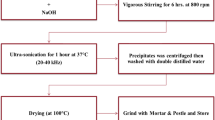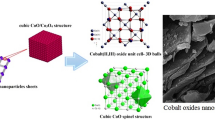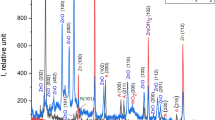Abstract
In this manuscript, the grown and annealed strontium-doped nickel oxide nanoparticles (SrNiONPs) were synthesized using a precipitation method with nickel nitrate and strontium nitrate as precursor agents with trisodium citrate. Various characterization techniques, including X-ray diffraction pattern (XRD), scanning electron microscopy (SEM), transmission electron microscopy (TEM), Fourier transform infrared spectroscopy (FTIR), UV–visible, and zeta sizer, were used to thoroughly examine the samples. The XRD pattern (21 nm) was used to calculate the size, phases, and crystallinity of the material (SrNiONPs). In addition to characterization, the material was tested for cytotoxicity in lung cancer cells (A549). The viability test in A549 cells was performed using [3-(4, 5-dimethylthiazol-2-yl)-2, 5 diphenyltetrazolium bromide] (MTT) and Neutral Red Uptake (NRU) assay with SrNiONPs concentration ranging from 1 to 100 μg/mL. According to the MTT and NRU data, the toxicity studies are dose-dependent. SrNiONPs also increased reactive oxygen species (ROS) and were involved in apoptosis (A549 cells). Furthermore, quantitative PCR (qPCR) data revealed that the mRNA levels of apoptotic genes marker like p53, bax, and caspase-3 were upregulated, whereas bcl-2, an anti-apoptotic gene, was downregulated. As a result, apoptosis was mediated by the p53, bax, caspase3, and bcl-2 pathways, implying a potential mechanism by which SrNiONPs mediate their toxicity.







Similar content being viewed by others
Data Availability
Available whenever requested.
References
Colarusso P, Guo B, Zhang KQ, Bernath PF (1996) High-resolution infrared emission spectrum of strontium monofluoride. J Mol Spectrosc 175:158–171
Teoh LG, Li KD (2012) Synthesis and characterization of NiO nanoparticles by sol gel method. Mater Trans 53:2135–2140
Garcia-Miquel JL, Zhang Q, Allen SJ, Rougier A, Blyr A, Davies HO (2003) Nickel oxide sol–gel films from nickel diacetate for electrochromic applications. Thin Solid Films 424:165–170
Ganachari SV, Bhat R, Deshpande R, Abbaraju V (2012) Synthesis and characte- rization of nickel oxide nanoparticles by self-propagating low temperature combustion method. Recent Res Sci Technol 4:50–53
Zorkipli NNM, Kaus NHM, Mohamad AA (2016) Synthesis of NiO nanoparticles through sol-gel method. Proc Chem 19:626–631
Dooley KM, Chen SY, Ross JRH (1994) Stable Nickel-containing catalysts for the oxidative coupling of methane. J Catal 145:402–408
Rao KV, Sunandana CS (2008) Co3O4 nanoparticles by chemical combustion: effect of fuel to oxidizer ratio on structure, microstructure and EPR. Solid State Commun 148:32–37
Hosny NM (2011) Synthesis, characterization and optical band gap of NiO nano parti cles derived from anthranilic acid precursors via a thermal decomposition route. Polyhedron 30:470–476
Rahdar A, Aliahmad M, Azizi Y (2015) NiO nanoparticles: synthesis and charac terization. J Nanosci 5:145–151
Xiang L, Deng XY, Jin Y (2002) Experimental study on synthesis of NiO nano particles. Scr Mater 47:219–224
Mohammadijoo M, Naderi Khorshidi Z, Sadrnezhaad SK, Mazinani V (2014) Synthesis and characterization of nickel oxide nanoparticle with wide band gap energy prepared via thermochemical processing. Nanosci Nanotechnol Int J 4:6–9
Capasso L, Camatini M, Gualtieri M (2014) Nickel oxide nanoparticles induce infla mmation and genotoxic effect in lung epithelial cells. Toxicol Lett 226:28–34
Halliwell B (2003) Oxidative stress in cell culture: an under-appreciated problem? FEBS Lett 540:3–6
Siddiqui MA, Kashyap MP, Kumar V, Khedhairy AAA, Musarrat J, Pant AB (2010) Protective potential of trans-resveratrol against 4-hydroxynonenal induced damage in PC12 cells. Toxicol In Vitro 24:1592–1598
Siddiqui MA, Singh G, Kashyap MP, Khanna VK, Yadav S, Chandra D, Pant AB (2008) Influence of cytotoxic doses of 4-hydroxynonenal on selected neuro transmitter receptors in PC-12 cells. Toxicol In Vitro 22:1681–1688
Borenfreund E, Puerner JA (1985) Toxicity determined in vitro by morphological alterations and neutral red absorption. Toxicol Lett 24(2–3):119–124
Fotakis G, Timbrell JA (2006) In vitro cytotoxicity assays: comparison of LDH, neutral red, MTT and protein assay in hepatoma cell lines following exposure to cadmium chloride. Toxicol Lett 160(2):171–177
Zhao J, Riediker M (2014) Detecting the oxidative reactivity of nanoparticles: a new protocol for reducing artifacts. J Nanopart Res 16(7):2493
Ahmad J, Wahab R, Siddiqui MA, Saquib Q, Khedhairy AAA (2020) Cytotoxicity and cell death induced by engineered nanostructures (quantum dots and nano particles) in human cell lines. J Biol Inorg Chem 2:325–338
Apsana G, George PP, Devanna N, Yuvasravana R (2018) Biomimetic synthesis and antibacterial properties of strontium oxide nanoparticles ocimum sanctum leaf extract. Asian J Pharm Clin Res 11(3):384–389
Anand GT, Nithiyavathi R, Ramesh R, Sundaram SJ, Kaviyarasu K (2020) Structural and optical properties of nickel oxide nanoparticles: investigation of antimicrobial applications. Surf Interface 18:100460
Iqbal J, Abbasi BA, Mahmood T, Hameed S, Munir A, Kanwal S (2019) Green synthesis and characterizations of nickel oxide nanoparticles using leaf extract of Rhamnus virgata and their potential biological applications. Appl Organomet Chem 33(8):e4950
Kim SH, Lee DH, Lee JH, Yang JY, Seok JH, Jung K, Lee JK (2021) Evaluation of the skin sensitization potential of metal oxide nanoparticles using the ARE-Nrf2 Luciferase KeratinoSensTM assay. Toxicol Res 37:277–284
Sioutas C, Delfino RJ, Singh M (2005) Exposure assessment for atmospheric Ultrafine Particles (UFPs) and implications in epidemiologic research. Environ Health Perspect 113:947–955
Kim YS, Lim CH, Shin SH, Kim JC (2017) Twenty-eight-day repeated inhalation toxicity study of nano-sized neodymium oxide in male Sprague-Dawley rats. Toxicol Res 33(3):239–253
Wang FS, Fan JG, Zhang Z, Gao B, Wang HY (2020) The global burden of liver disease: the major impact of China. Hepatol Rev 60:2099–2108
Ahmad J, Alhadlaq HA, Alshamsanc A, Siddiquia MA, Saquib Q, Khan ST, Wahab R, Khedhairy AAAl, Musarrat J, Akhtar MJ, Ahamed M, (2016) Differential cytotoxicity of copper ferrite nanoparticles in different human cells. J Appl Toxicol 36(10):1284–1293
Ahmad J, Alhadlaq HA, Siddiqui MA, Saquib Q, Khedhairy AAA, Musarrat J, Ahamed M (2015) Concentration-dependent induction of reactive oxygen species, cell cycle arrest and apoptosis in human liver cells after nickel nanoparticles exposure. Environ Toxicol 30(2):137–148
Funding
The authors are grateful to the Deanship of Scientific Research, King Saud University for funding through Vice Deanship of Scientific Research Chairs.
Author information
Authors and Affiliations
Contributions
J Ahmad: conceptualization, methodology, project administration writing–review and editing, and writing–original draft. R Wahab: methodology, data curation, conceptualization, and software. MA Siddiqui: conceptualization, methodology, investigation, and formal analysis. Q Saquib: methodology, validation, and formal analysis. N Ahmad: software and formal analysis: AA Al-Khedhairy: conceptualization and funding acquisition.
Corresponding author
Ethics declarations
Ethics Approval
We are using human cancer cell lines purchased from ATCC. In our case, no ethical approval is required.
Consent to Participate
Not applicable.
Consent for Publication
The authors approve processing this manuscript for publication.
Competing Interests
The authors declare no competing interests.
Additional information
Publisher's Note
Springer Nature remains neutral with regard to jurisdictional claims in published maps and institutional affiliations.
Rights and permissions
About this article
Cite this article
Ahmad, J., Wahab, R., Siddiqui, M.A. et al. Strontium-Doped Nickel Oxide Nanoparticles: Synthesis, Characterization, and Cytotoxicity Study in Human Lung Cancer A549 Cells. Biol Trace Elem Res 200, 1598–1607 (2022). https://doi.org/10.1007/s12011-021-02780-5
Received:
Accepted:
Published:
Issue Date:
DOI: https://doi.org/10.1007/s12011-021-02780-5




